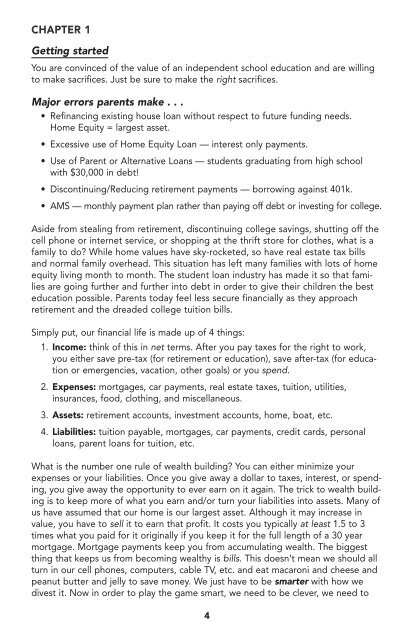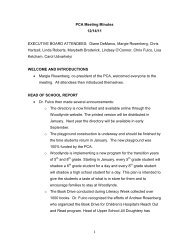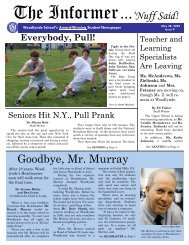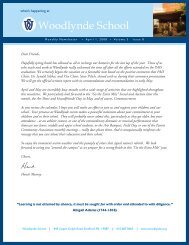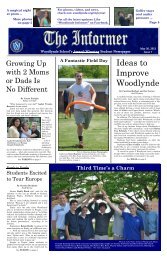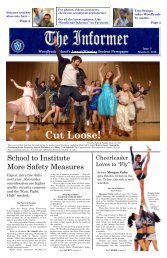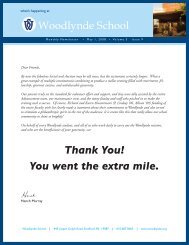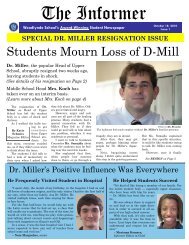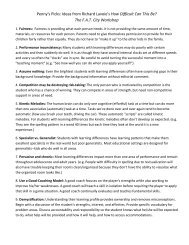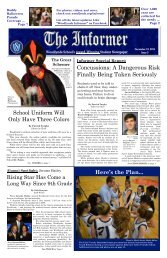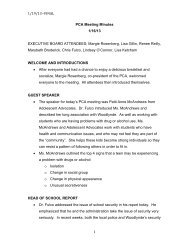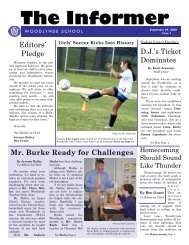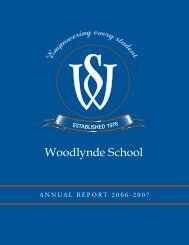ADVIS Financial Strategies - Woodlynde School
ADVIS Financial Strategies - Woodlynde School
ADVIS Financial Strategies - Woodlynde School
You also want an ePaper? Increase the reach of your titles
YUMPU automatically turns print PDFs into web optimized ePapers that Google loves.
CHAPTER 1<br />
Getting started<br />
You are convinced of the value of an independent school education and are willing<br />
to make sacrifices. Just be sure to make the right sacrifices.<br />
Major errors parents make . . .<br />
• Refinancing existing house loan without respect to future funding needs.<br />
Home Equity = largest asset.<br />
• Excessive use of Home Equity Loan — interest only payments.<br />
• Use of Parent or Alternative Loans — students graduating from high school<br />
with $30,000 in debt!<br />
• Discontinuing/Reducing retirement payments — borrowing against 401k.<br />
• AMS — monthly payment plan rather than paying off debt or investing for college.<br />
Aside from stealing from retirement, discontinuing college savings, shutting off the<br />
cell phone or internet service, or shopping at the thrift store for clothes, what is a<br />
family to do? While home values have sky-rocketed, so have real estate tax bills<br />
and normal family overhead. This situation has left many families with lots of home<br />
equity living month to month. The student loan industry has made it so that families<br />
are going further and further into debt in order to give their children the best<br />
education possible. Parents today feel less secure financially as they approach<br />
retirement and the dreaded college tuition bills.<br />
Simply put, our financial life is made up of 4 things:<br />
1. Income: think of this in net terms. After you pay taxes for the right to work,<br />
you either save pre-tax (for retirement or education), save after-tax (for education<br />
or emergencies, vacation, other goals) or you spend.<br />
2. Expenses: mortgages, car payments, real estate taxes, tuition, utilities,<br />
insurances, food, clothing, and miscellaneous.<br />
3. Assets: retirement accounts, investment accounts, home, boat, etc.<br />
4. Liabilities: tuition payable, mortgages, car payments, credit cards, personal<br />
loans, parent loans for tuition, etc.<br />
What is the number one rule of wealth building? You can either minimize your<br />
expenses or your liabilities. Once you give away a dollar to taxes, interest, or spending,<br />
you give away the opportunity to ever earn on it again. The trick to wealth building<br />
is to keep more of what you earn and/or turn your liabilities into assets. Many of<br />
us have assumed that our home is our largest asset. Although it may increase in<br />
value, you have to sell it to earn that profit. It costs you typically at least 1.5 to 3<br />
times what you paid for it originally if you keep it for the full length of a 30 year<br />
mortgage. Mortgage payments keep you from accumulating wealth. The biggest<br />
thing that keeps us from becoming wealthy is bills. This doesn’t mean we should all<br />
turn in our cell phones, computers, cable TV, etc. and eat macaroni and cheese and<br />
peanut butter and jelly to save money. We just have to be smarter with how we<br />
divest it. Now in order to play the game smart, we need to be clever, we need to<br />
4


